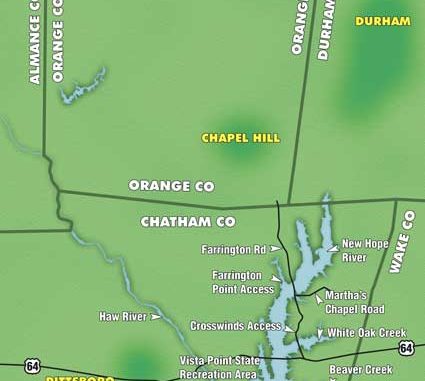
Once the piedmont’s premier bass spot, Jordan Lake rebounds as a ‘hawg’ heaven.
During the late 1980s, Jordan Lake, an impoundment divided by U.S. 64 east of Pittsboro, was the hottest largemouth reservoir in North Carolina.
Anglers regularly caught 50 to 100 largemouth bass a day, the majority 2- and 3-pound football-shaped lunkers with 8- and 10-pounders common. The U.S. Army Corps of Engineers closed the dam in 1984, so Jordan had only recently been flooded, and largemouths flourished.
A few years after the bass boom began, it crashed. Studies by N.C. Wildlife Resources Commission fisheries biologists revealed few small bass. What the biologists call “recruitment” — a successful spawn which guarantees replacement of mature fish by new generations — seemed to have failed. For a number of years, bass fishing became tough at Jordan.
Today Lake Jordan has recovered, considering the results of numerous bass tournaments. For more than a decade, team tournament winners often have brought five-fish, 20-pound-and-larger catches to weigh-ins, and scientific studies have confirmed tournament results.
The only problem in 2008 for anglers at Jordan Lake may be low water levels. North Carolina’s 2007 drought and few scattered rains periodically have lowered and raised the lake’s surface. However, most of Jordan’s launch ramps are open (during January the lake was only 2 feet below normal pool and February rains raised it even more).
Low water levels actually may help anglers because it concentrates fish in smaller areas. The major concern at Jordan will be the shallow Haw River arm where boaters need to be wary of obstructions normally covered by deeper water.
For information about the lake’s daily water level, call the Ranger station at (919) 362-0586 or the U.S. Army Corps of Engineers at the Jordan dam at (919) 542-4501 and press 1.
“The most recent survey (of Jordan) was conducted in May 2006 using shoreline electro-fishing techniques,” said Brian McRae, the WRC’s Piedmont fisheries research coordinator.
Electrofishing is done from a boat equipped with an electric generator. As the boat makes its way along the bank, charged probes dangle off the front of the boat and extend into the water. When a switch is thrown, fish in the immediate area are stunned and float to the surface. It’s not unlike the old-time technique meat hunters used with a crank telephone and wires that electrified the water and brought stunned fish to the surface where they could be netted.
While floating, the fish are netted and placed in a holding tank. Individual fish are weighed, measured, and assessed as to their overall health. Fish are released in the area where they were captured and swim away none-the-worse-for-wear.
“The results from this survey suggest that Jordan Reservoir continues to maintain an excellent largemouth bass fishery,” McRae said.
The catch rate of electrofishing at Jordan was 66 largemouth per hour while that in other Piedmont reservoirs averaged 30 to 60 per hour.
“Jordan was just above the average range in a Piedmont reservoir,” McRae said.
So anglers’ chances of catching largemouth at Jordan should be a little better than at comparable spots in North Carolina. Simply put, bass are slightly more abundant in the lake than elsewhere, with only nearby (and smaller and more-pressured) Shearon Harris Lake having a higher rating.
“Not only were a good number of fish collected, but approximately 30 per cent of the largemouth bass collected were greater than 16-inches (long),” McRae said. “In general, Jordan is a great place to catch some 15- to 20-inch largemouth bass. However, we rarely collect a largemouth bass greater than 25 inches.”
A 25-inch-long largemouth is rare and a genuine trophy for any body of water. No one should be surprised the Jordan study didn’t find extremely large lunkers that frequently.
Jordan’s recovery is in part a function of a WRC-imposed 16-inch minimum-size limit that assures largemouth make at least one spawning cycle before being harvested. Also, during the last few years, recruitment has been good.
“Age data indicate that largemouth bass are having successful spawns and juvenile survival is relatively high as approximately 45 per cent of the fish collected were ages 1 and 2,” McRae said. “Also, growth rates and condition appear to be fairly stable and in good shape.”
High water fishing
Mike Dinterman, owner-operator of Trophy Bass Fishing Guide Service, has plied his craft at Jordan for many years. Speaking from personal experience, Dinterman and his clients catch lots of Jordan largemouth.
“March can be pretty good at Jordan,” said the veteran guide with typical understatement. “If the water level is up, the best bet will be flipping and pitching the bushes.
“There are lots of spots at Jordan where high water floods shoreline bushes, even some isolated patches of bushes away from the shore.”
Dinterman suggested Texas-rigged lizards or jig-and-pig combos for flipping and pitching the bushes.
If using a Texas-rig, pegging the weight close to the lizard will prevent the lead bullet from falling on one side of a branch and the lizard on the other. A small toothpick jammed into the hole in the weight will work.
But the toothpick method also pinches the line, weakening it. A better way to keep the weight and lizard together is with a knotted piece of monofilament which can be slid close to the head of the weight. A suitable knot is half a blood knot. Pull the knot tight and slide it to the weight.
Whether fishing a Texas-rig or a jig, a 3/8-ounce-or-heavier weight will assist a lure in dropping through the branches of bushes toward the bottom where the largemouth will be. Stout line helps fishing the dense branches of Jordan’s bushes.
Spiderwire recently released Invisi-Braid, a translucent braided line. The 50-pound-test version mimics the size of
12-pound monofilament. A heavy fluorocarbon leader, 5- or 6-feet long, would be a good accompaniment to the braided line. Make a perfection loop in the fluorocarbon and tie the braided line to the fluorocarbon with an Albright knot.
Whatever the line choice, wrestling a feisty largemouth out of thick cover requires no-nonsense line. It’s “feel-a-bite-and-snatch” fishing. A stout casting rod at least 6 ½-feet long works best for fishing the bushes.
“If the water is both high and colored, try a big spinnerbait through the brushes,” Dinterman said.
Big Colorado blades will help knock branches off the spinnerbait. As a spinnerbait passes through the branches, let it drop, then pull it up and over the next branch — and hang on.
Normal water levels
If the shoreline bushes aren’t flooded, Dinterman suggested alternatives.
“If the water is not up, not in the bushes, slow roll a ¾-ounce spinnerbait,” he said.
Slow rolling is a spinnerbait technique wherein an angler retrieves slowly enough to keep the lure close to the bottom but fast enough to feel the rotation of the spinnerbait’s blades.
While many anglers believe Colorado-bladed spinnerbaits work best for this technique, Dinterman recommended a different method with a tandem blade spinnerbait.
“The best spinnerbait for this technique at Jordan is one with a No. 6 willowleaf blade,” he said.
If the shoreline bushes aren’t flooded, Dinterman suggested backing off the shore to catch Jordan largemouth.
“Slow roll the spinnerbait through 3 to 6 feet of water,” he said. “Keep the boat a cast and a half from the bank and fish the main-lake points.”
Various levels
Independent of the rise or fall of the water level, there are places to fish Jordan Lake that are better than others, Dinterman said.
“In March don’t overlook the small creeks,” he said.
Among those he suggested, were Stinking Creek and Roberson Creek in the Haw River section. At the New Hope Creek arm, consider Beaver Creek, Little Beaver Creek and White Oak Creek.
The Narrows, the portion of Jordan upstream from the junction of the New Hope Creek and Haw River along the New Hope Creek to Channel Marker 3 is also a prime early spring largemouth location.
Dinterman also uses Carolina-rigged worms and they work well at Jordan Lake. My son Craig caught his first 5-pound largemouth at Jordan many years ago suing a Carolina rig.
“The key to hooking fish on the Carolina rig is feeling the fish,” Dinterman said. “With a Texas-rig, you don’t want the fish to feel you until you set the hook. But with a Carolina-rig it’s a lot like playing tug-of-war with a dog. As long as he feels you pulling, he’ll hang on.”
To set the hook with a Carolina-rig, Dinterman recommended continuous tension on the line.
“If you drop back to set the hook, a Jordan largemouth will drop the worm,” he said.
In particular, Dinterman suggested the Carolina rig as a means to catch a number of male largemouth in the pre-spawn period.
In the last couple of years, Jordan anglers have joined the widespread use of the so-called “shaky worm.”
“The shaky worm is really nothing new,” Dinterman said. “It’s really nothing but a worm rigged on a jig rather than a single hook and a slip sinker.”
Typically, shaky-worm fans rig a relatively small, slender worm on a standup jig head. Yum makes a 4 1/2-inch-long worm called a Yum Forked Dinger which is popular for shaky rigs. Light jig heads, no larger than 1/8 ounce, are used with shaky worms.
This rig is called “shaky” because it’s fished by letting it settle to the bottom in a likely spot. While there, the worm is merely shaken rather than fished in the common lift-and-fall approach common to Texas-rig users.
Shaky worm anglers typically fish with spinning gear and 8- or 10-pound-test line. Strikes often are detected only as a heavy feeling on the line or a loss of contact with the jig.
Among the “always-a-good-ideas” at Jordan, Dinterman suggested fishing near rip rap.
“Along any stretch of rip rap is always a good spot for spring largemouth at Jordan,” he said.
Lengthy stretches of rip rap mark the lake where Farrington Road crosses New Hope and White Oak Creeks, where Beaver Road crosses Beaver Creek, and where U.S. 64 crosses the New Hope Creek arm.
Among the productive spots along the rip rap, note the causeway where Farrington Road crosses the New Hope Creek. Folkner Creek used to run into the New Hope Creek near Martha’s Chapel Road. The creek bed now is covered by the causeway, but about halfway between where Martha’s Chapel Road deadends at Farrington Road — from the water the road sign should be visible — and the bridge across the New Hope Creek, the vestigial creek bed remains, and it’s a good spot.
Small crankbaits — a No. 5 or No. 7 Shad Rap or Balsa Model B — are prime lures to use at rip rap.
When Jordan was flooded, large stands of timber were left to provide fish habitat. Although many of the trees have fallen in the water, many remain, and they hold springtime lunkers.
“In early spring, the back side of the timber is a good option,” Dinterman said. “One of my favorites is the timber near Farrington Point.”
Other prime timber stands are found near Vista Point Recreation Area.
Forage and color
“At Jordan, gizzard shad, threadfin shad and sunfish are the primary forage species for largemouth bass,” McRae said. “In fact, we have been fortunate with Jordan in that undesirable forage species, such as alewives and blueback herring have not been introduced. Alewives and blueback herring can alter the structure and complexity of the food web and we don’t want to see them in Jordan.”
Clearly, the recent data from Jordan indicate forage for largemouth bass is readily available.
Dinterman suggested anglers who select favorite colors likely will see them work.
“Confidence is a more important factor,” he said. “Folks should use colors they have the most confidence in.”
Given the forage species, shad colors, silver-with-blue back, silver-with-black back or silver-with-green back are good choices for crankbaits. Natural colors work for plastics, lizards and worms. So try watermelon, perhaps with a chartreuse tail, during sunny days and Junebug when it’s cloudy.
Adjacent to the rip rap, try a lipless crankbait, a Rat-L-Trap or a Spot. Red is an excellent color choice for lipless crankbaits in addition to the shad colors to match spring crawfish patterns.
Early spring is a great time for Tar Heel largemouth bass anglers. Largemouth are staging in a pre-spawn mode.
Lakes such as Jordan are teeming with bass, maybe not eager to go for a short boat ride, but nonetheless aggressive and feisty.


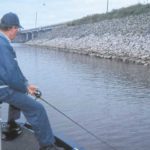
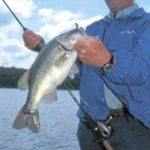
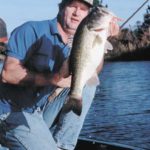
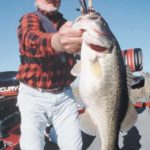
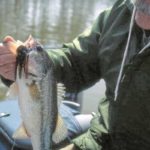
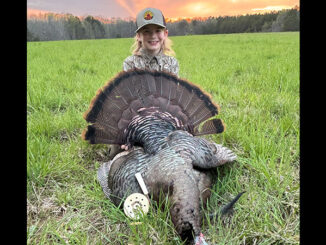
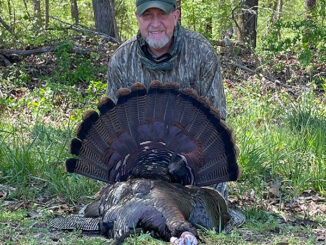
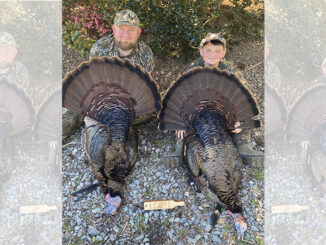
Be the first to comment